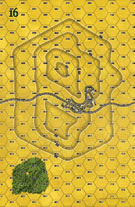|
|
|
Total |
| Side 1 |
0 |
| Draw |
0 |
| Side 2 |
0 |
|
Total |
| Side 1 |
0 |
| Draw |
0 |
| Side 2 |
0 |
|
Total |
| Side 1 |
0 |
| Draw |
0 |
| Side 2 |
0 |
|
| Overall Rating, 0 votes |
|---|
|
|
|
Scenario Rank:
of |
| Parent Game |
Hammer & Sickle |
| Historicity |
Alt-History |
| Date |
1948-08-01 |
| Start Time |
06:00 |
| Turn Count |
20 |
| Visibility |
Day |
| Counters |
50 |
| Net Morale |
0 |
| Net Initiative |
0 |
| Maps |
1: 16 |
| Layout Dimensions |
43 x 28 cm
17 x 11 in |
| Play Bounty |
198 |
| AAR Bounty |
222 |
| Total Plays |
0 |
| Total AARs |
0 |
| Duplicates |
IrCu008 |
|
Introduction
|
|
Armored divisions made the breakthroughs and the headlines during World War II, but in all armies most of the fighting was done by the poor, bloody infantry. In the United States, infantry weapons remained those with which foot soldiers had fought the Nazis. In the Soviet Union, a new wonder weapon in development, the AK-47, would not see widespread distribution until the 1950s.
|
|
Conclusion
|
|
Eighteen National Guard divisions were called into federal service for the Second World War. Some of them, like the Dixie Division, compiled excellent war records - the 31st fought in the jungle hell of New Guinea, and as one of the few Guard units to retain its peacetime civilian commander. A major war against the Soviet Union would have brought the Guard back into the field, with units well-laced with combat veterans but lacking large-unit training.
|
Display Relevant AFV Rules
| AFV Rules Pertaining to this Scenario's Order of Battle |
- Vulnerable to results on the Assault Combat Chart (7.25, 7.63, ACC), and may be attacked by Anti-Tank fire (11.2, DFT). Anti-Tank fire only affects the individual unit fired upon (7.62, 11.0).
- AFV's are activated by tank leaders (3.2, 3.3, 5.42, 6.8).
They may also be activated as part of an initial activating stack, but if activated in this way would need a tank
leader in order to carry out combat movement.
- AFV's do not block Direct Fire (10.1).
- Full-strength AFV's with "armor efficiency" may make two anti-tank (AT) fire attacks per turn
(either in their action segment or during opportunity fire) if they have AT fire values of 0 or more
(11.2).
- Each unit with an AT fire value of 2 or more may fire at targets at a distance of between 100% and 150% of its
printed AT range. It does so at half its AT fire value. (11.3)
- Efficient and non-efficient AFV's may conduct two opportunity fires per turn if using direct fire
(7.44, 7.64).
Units with both Direct and AT Fire values may use either type of fire in the same turn as their opportunity fire,
but not both (7.22, 13.0).
Units which can take opportunity fire twice per turn do not have to target the same unit both times (13.0).
- Demoralized AFV's are not required to flee from units that do not have AT fire values (14.3).
- Place a Wreck marker when an AFV is eliminated in a bridge or town hex (16.3).
- AFV's do not benefit from Entrenchments (16.42).
- AFV's may Dig In (16.2).
- Open-top AFV's: Immune to M, M1 and M2 results on Direct and Bombardment Fire Tables, but DO take step losses from X and #X results (7.25, 7.41, 7.61, BT, DFT). If a "2X" or "3X" result is rolled, at least one of the step losses must be taken by an open-top AFV if present.
- Self-Propelled Artillery: do not provide the +1 Assault bonus, even if closed-top (SB)
|
Soviet Union Order of Battle
United States Order of Battle
| 1 Errata Item |

|
The reduced direct fire value in Kursk: Burning Tigers is 4-4.
|





 HaSi027
HaSi027 




















